Argentina are exactly where everyone expected them to be at this stage of the tournament. The World Champions quite comfortably navigated their way out of their group, winning all three of their matches without conceding a goal. However, an average display against Ecuador saw the pre-tournament favourites taken to a penalty shootout after a 1-1 draw in normal time. As seen in their past tournament triumphs, the brilliance of Emi Martínez secured another penalty shootout victory, keeping them on track to retain the Copa América.
Canada on the other hand have exceeded expectations. The addition of the six CONCACAF nations has really added a different dimension to the tournament. The USA and Mexico, who both have a rich history in the tournament, would have been touted pre-tournament to go the furthest out of the CONCACAF sides. Yet, it has been Canada who have gone the deepest in the competition. At the beginning of a new regime, Jesse Marsch led Canada to the semi-final in their first Copa América. Finishing second in what was a tricky group and overcoming an inform Venezuela in the quarter-finals, Les Rougues have caught most people by surprise.
The two sides have already met each other in the group stage, in what was the opening game of the tournament. Argentina won the game comfortably, with Canada still getting to grips with Marsch’s style. Now, meeting in the semi-finals, in this tactical analysis in the form of a tactical preview, we will provide an analysis of the key areas where this game will be won and lost. Analysis of both teams’ tactics, strengths and weaknesses, which have been displayed throughout the tournament, will be highlighted.
Lineups
Argentina, on paper, have lined up throughout the tournament, playing a 4-4-2. Lionel Scaloni has not been afraid to change the personnel of his side, with his squad possessing an enormous amount of talent. The ever-present and reliable Emi Martínez will start in nets behind the solid back four of full-backs Nicolás Molina and Nicolas Tagliafico, with Premier League duo Lisandro Martínez and Cristian Romero starting at centre-back together. The midfield four will consist of Rodrigo De Paul, playing on the right, Alexis Mac Allister and Enzo Fernández in central midfield alongside Nicolás González, who will be deployed as a traditional winger on the left. The tournament’s current top goalscorer, Lautaro Martínez, will start up front, with Lionel Messi given his customary free role.
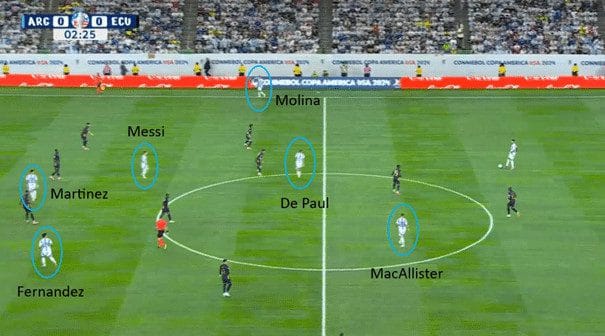
In possession, Argentina will gain width from right-back Molina and left-winger Nicolás González. Rodrigo de Paul will come inside and operate as a third central midfielder, with Mac Allister and particularly Fernández often given licence to roam. Lautaro Martínez, like substitute option Julián Álverez, will have the ability to drop deep when needed, yet the Inter striker will look to stretch Canada’s backline.
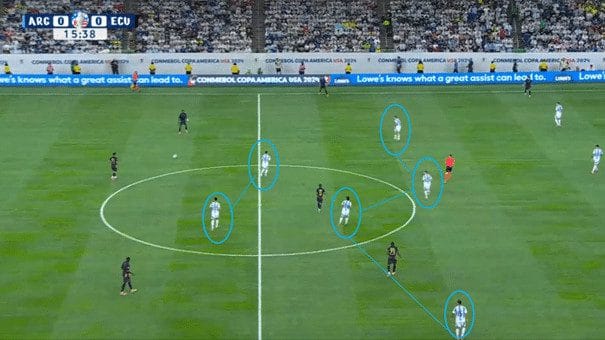
The team will line up in a traditional 4-4-2 formation out of possession. Martínez and Messi will make up the front two; however, Messi will be given limited responsibility when defending. De Paul will revert to playing like a traditional wide player out right and will offer the protection that is needed with many of the opposition’s build-up by passing Messi on the right side of the pitch.
Canada, like Argentina, will line up playing 4-4-2. Maxime Crepeau, who has been outstanding in the tournament, will start in goal. The back four has remained largely the same throughout the competition. Celtic’s Alistair Johnston, who has been ever-present, will continue at right-back, and Captain Alphonso Davies will likely remain in his natural left-back position.
The unbroken partnership of Moise Bombito and Derek Cornelius will carry on at centre half. Jonathan Osorio and Stephen Eustáquio will maintain their starting spots in the middle of the park, while the impressive Jacob Shaffelburg will play on the left wing, with Richie Laryea on the opposite flank. Up front, Lille’s Jonathan David will partner Mallorca striker Cyle Larin.
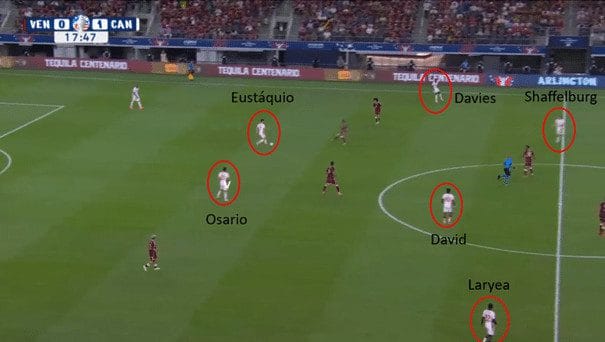
In possession, Canada have good balance throughout their team. Johnston will provide security to the defence as Davies will bomb forward on every occasion. Laryea and Shaffelburg will come inside at times, although with both playing on their natural side, they will normally drift out wide to deliver balls into the box. Osorio and Eustáquio will sit deeper, with Jonathan David dropping deep, operating more as a number 10 in possession. Larin will provide the vocal point upfront, playing as a target forward.
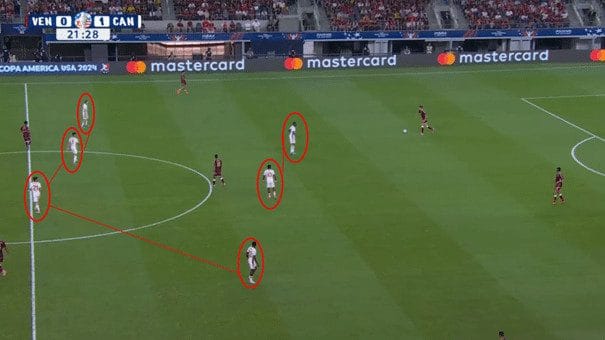
Out of possession, Canada will remain in their compact 4-4-2 shape. David and Larin will screen passes into midfield, forcing the ball to be played out wide. As the ball is played wide, Canada’s wingers and full-backs will come alive and begin an intense press.
Wide Areas: Canada’s greatest opportunity to exploit Argentina
Having players in wide areas such as Alphonso Davies, Alistair Johnston and Tajon Buchanan playing for elite European clubs, many would have foreseen Canada gaining their most attacking success on the flanks. This has proven to be the case, with Canada averaging 14 crosses per 90 and Nashville SC winger Shaffelburg currently having the second-most completed crosses into the penalty area in the tournament. However, despite the individual brilliance of Canada’s wide players, many of Canada’s tactical components have led to much of their productivity on the flanks.
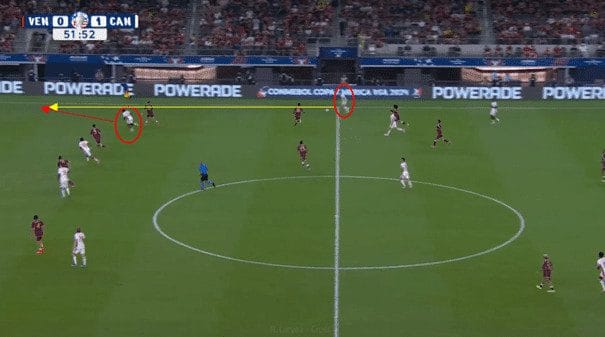
A consistent feature of Canada’s attacks on the flanks has been the in-to-out runs, which have released their wide attackers into promising situations. As seen in this situation, Laryea makes an excellent run in the channel and is found by Alistair Johnston. This allows for a dangerous cross to be delivered, creating a great opportunity for Canada.
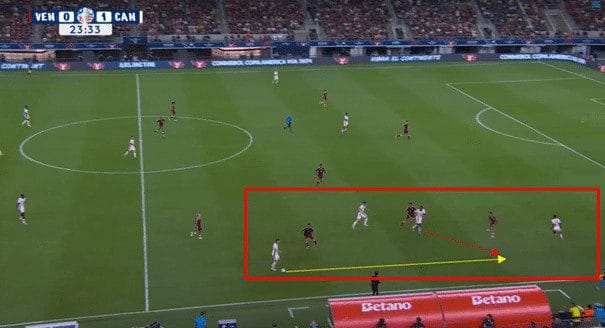
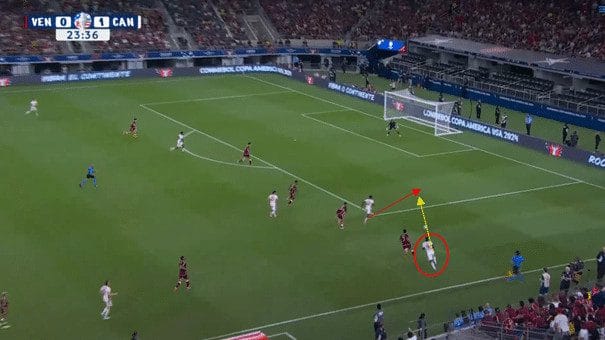
Another ploy that Canada have used to progress down the flanks is creating overloads. Here, we see Larin pulling out wide to create a 4v3. This allows him to get free of marking and make a dangerous pass to Richie Laryea, who’s cutback creates a clear opportunity for Canada.
Where Canada have thrived when attacking in wide areas, Argentina’s defence has faltered when dealing with threats from the flanks. Statistically, this can be seen from the performance of their most used full-backs, Molina and Tagliafico. In this tournament Molina has a percentile rank of only 40 for tackles when compared with other full-backs and an even lower percentile rank of 37 for dribblers tackled. Tagliafico’s numbers are again poor, with the Lyon left-back having a percentile rank of 21 for tackles and 13 for dribblers tackled.
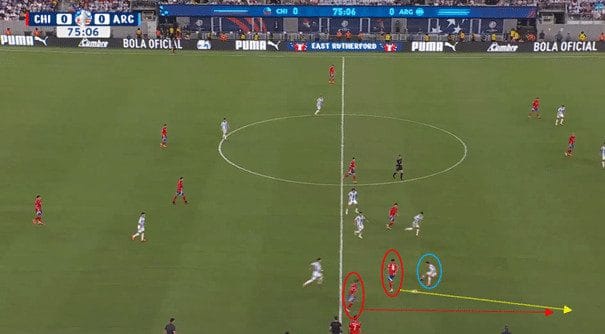
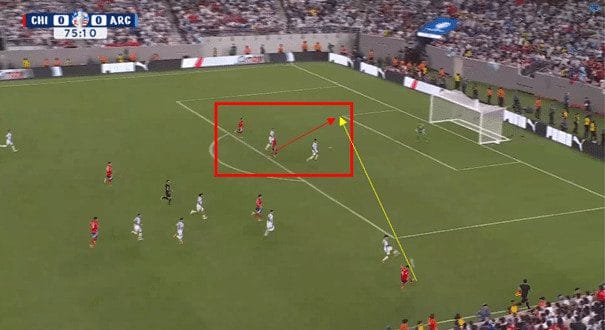
In this example, we see an example of Tagliafico’s lack of defensive awareness. He fails to read the overlap from the opposition’s full-back, allowing him to play a pass. Lisandro Martínez is dragged out of position to cover for his left back in an attempt to block the opponent’s cross. However, this leaves a 2v2 situation in the box and with both of Argentina’s defenders facing their own goal, it is a favourable situation for the attackers. The cross eventually leads to a shot on Argentina’s goal. Argentina will hope that Canada continues to fail at capitalising on the chances that they create, with the North American side having only scored two goals all tournament despite have an expected goals figure of 4.96.
Midfield Battle: Argentina’s greatest attacking strength
Where Canada seek to dominate the wide areas, Argentina look to overload the middle of the pitch. Argentina will normally seek to maintain possession and carefully progress the ball through the middle of the pitch. They have had the highest average percentage of possession in the tournament, 63%. Playing against sides who sit deeper to defend against their array of stars, the midfielders and forwards rotate to provide opportunities to progress the ball.
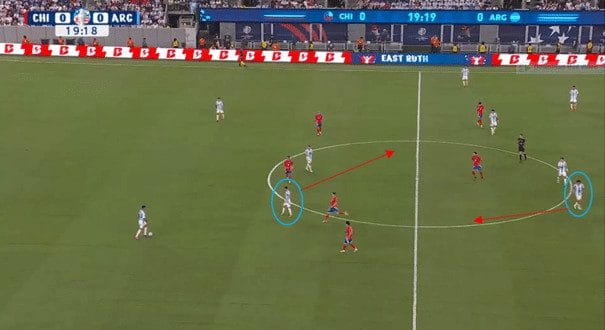
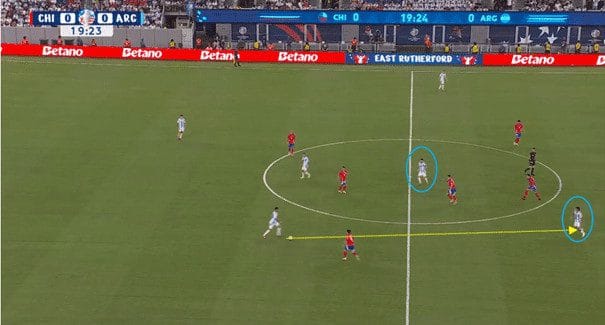
Here, we see Rodrigo De Paul as the highest midfielder, with Messi dropping deep to receive the ball. Messi is closely marked, so moves away from the man on the ball, taking his marker with him. This opens a passing lane for De Paul, who drops into the space created by Messi to receive the ball.
Argentina have had no problems when they’ve looked to progress the ball. They have the second-highest number of through balls in the tournament, averaging 32 progressive passes per 90. Messi and De Paul both rank in the top 10 for key passes. Argentina did get particular joy against Canada when playing through the middle, completing eight through balls.
Canada’s set-up is compact and seeks to force the opponent to play out wide, combating Argentina’s attacking focus. Nevertheless, Marsch’s use of a high line in their opening game proved detrimental and allowed Argentina to create several clear-cut chances.
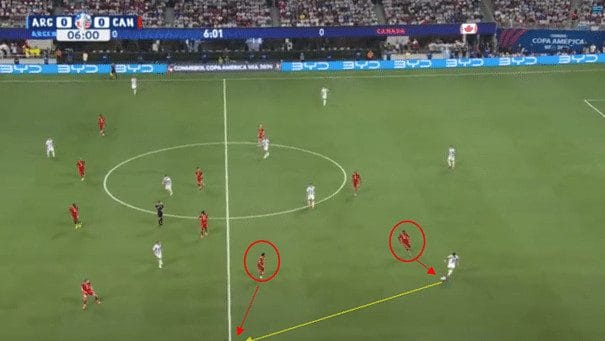
Here, we see Larin pressing Lisandro Martínez so that he is forced to play out wide. As the ball is played to the full-back, winger Tajon Buchanan increases the intensity of the press and seeks to win the ball. This again stops the ball from coming inside.
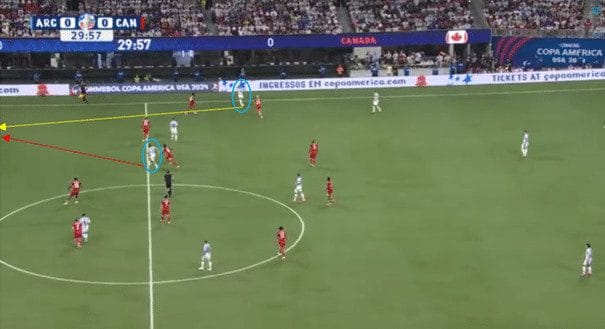
Despite Canada’s intense press helping them to win the ball back on several occasions, it proved harmful on multiple occasions. In this example, Di Maria has the ball close to the touchline. As he’s being pressed, he quickly plays a ball through Canada’s backline for the deep run of Rodrigo De Paul, taking advantage of Canada’s high line. Canada have appeared far more resolute against the opposition they have faced throughout the tournament, only suffering a combined total of four through balls in the three matches they have faced after Argentina.
Transitions: Where Argentina thrive and Canada must improve
A key element of Argentina’s success in this tournament has been counterpressing. During the defensive transition, the La Albiceleste work hard to gain possession, aggressively pressing to win the ball back from their opponents as soon as it’s lost.
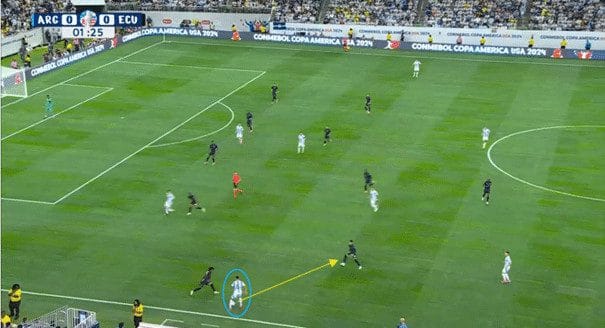
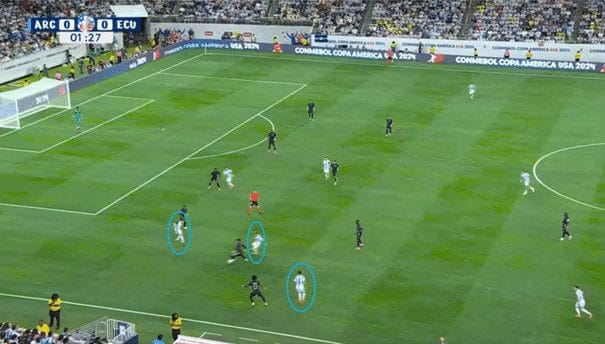
Here, we see the ball being given away out wide. Immediately, the interceptor is put under great pressure by several defenders and forced out wide, preventing him from playing forward and allowing Argentina to win the ball back.
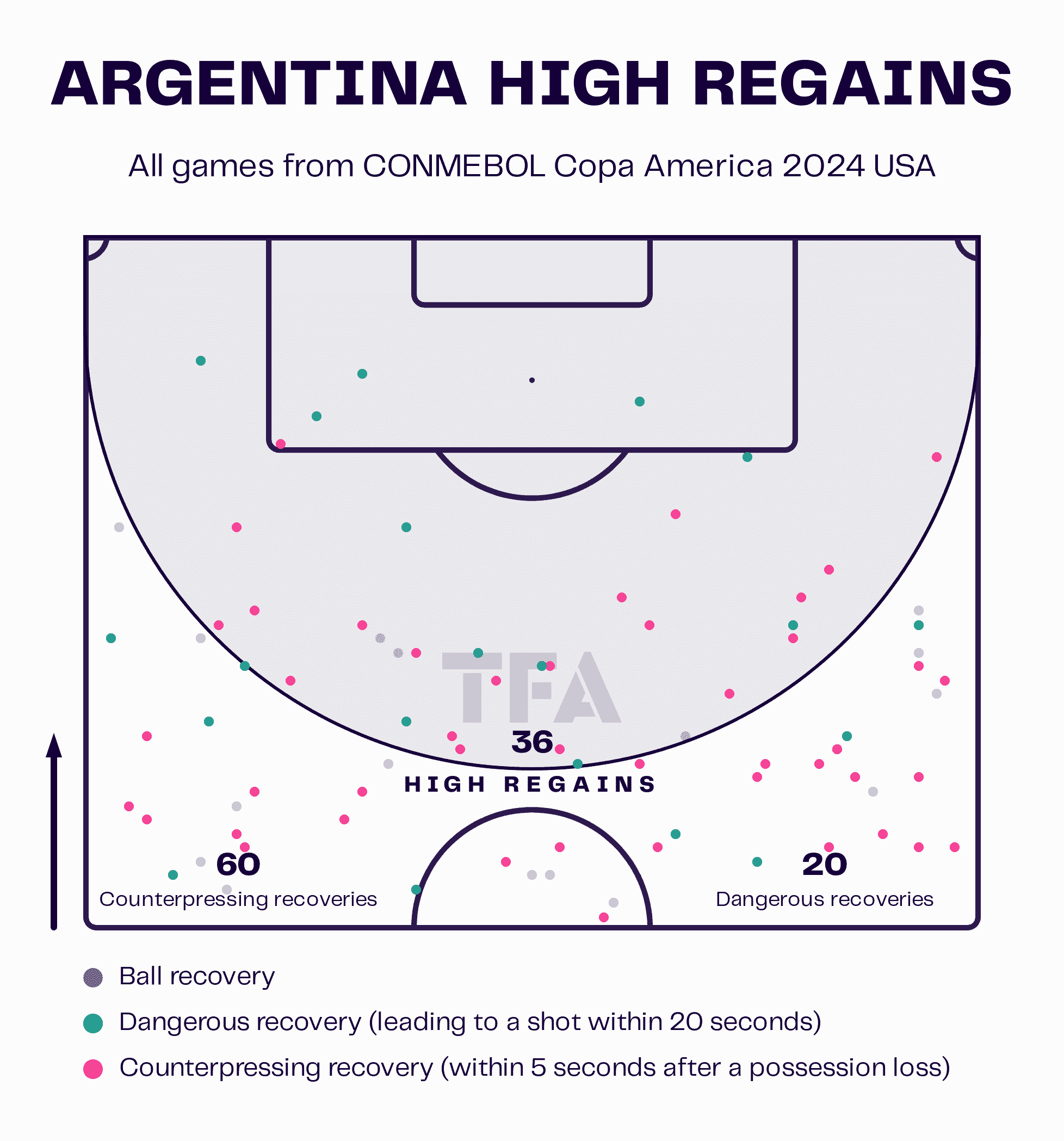
As seen in this graphic, Argentina have a high number of counterpressing regains in the opponents’ half. A significant number of their high regains have also led to clear opportunities, as demonstrated by the 20 dangerous recoveries. So far in the tournament, Argentina has the second-highest PPDA, 7.08.
This could be a crucial area if Argentina are to get the better of Canada again. Canada have proven that they are often sloppy after winning the ball. They rank second for ball losses in the tournament. Numbers also show their lack of proficiency during the attacking transition, having only managed to average 1.25 counterattacks per 90.
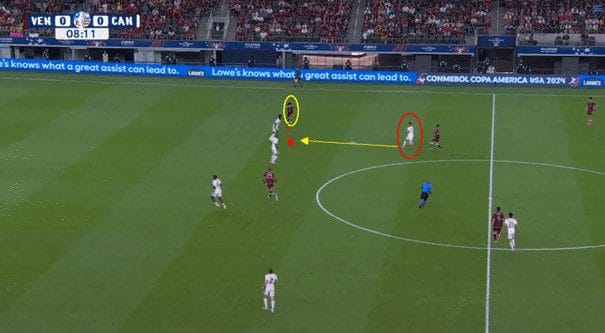
In this scenario, Canada have just won the ball back. The usually reliable Stephen Eustáquio aims to play the first pass of their possession back to one of his central defenders. He has failed to notice the proximity of one of the opponent’s attackers, who quickly intercepts the pass and helps his team begin a dangerous attack. It will be expected that Canada will have large spells without the ball and will come under severe pressure at times from Argentina. An inability to counter effectively could prove costly.
Prediction
This game could go right to the wire. Argentina have played well in this tournament and still have the squad fitting of their title of World Champions. They can call upon individuals who, with a moment of magic, can win any game. Yet Canada themselves have the capabilities to pull off a famous victory. Exploiting the wide areas may prove to be the avenue that Canada can use to cause an upset. If Canada can improve on the offensive transition and withstand Argentina’s fierce counterpress, they can take the game to penalties.
Both teams had to win a penalty shootout to reach this stage of the tournament. It would be an amazing matchup between two of the tournament’s standout goalkeepers, Crepeau and Martínez. Despite the belief that penalties are a lottery, Argentina’s quality and expertise in these situations should be enough to see them through.





Comments